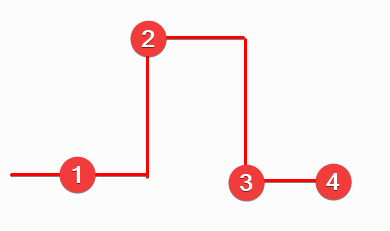The claims GoldenSound is making about the Ares II
not being able to do true NOS (in NOS mode), and that a triangle-shaped step response is proof of false NOS is non-nonsensical.
For example, look at :
https://www.kitsunehifi.com/nosvsos/
Also look at JA's metrics: Look at NOS curves for Holo May:
https://www.stereophile.com/content/holoaudio-may-level-3-da-processor-measurements
The triangle shaped IR is proof because it is not something that can be implemented in the analog domain and could not possibly result from NOS operation.
A NOS impulse can either be a straight NOS/Zero-Order-Hold impulse (which will show effectively a square wave of 1 sample width), or if there is an analog low-pass filter such as in the Holo or Metrum DACs then the rectangle will appear rounded because of the frequencies above 80khz (or whatever the LPF is configured for) are attenuated.
Linear interpolation requires digital domain processing as it requires advance knowledge of the value of the next sample.
Additionally, looking at the IR at a higher sample rate you can see the individual steps caused by the true sampling rate of the DAC. (These would not be present if it were either NOS or an analog domain implementation)
There is also the mathematical demonstration of rolloff. The rolloff @ nyquist is predictable and the Ares 2 follows the expected level for linear interpolation, and rolls off more than a NOS dac would.
This is not to say this is a 'bad' thing.
Filter design IMO is a preference thing and whilst some are overall more appropriate or questionable than others at the end of the day if you like the resulting sound of any particular reconstruction approach that's great.
The issue is that calling this 'NOS' is not accurate.
A bit of further info copied from my Terminator Plus written post:
Looking at NOS first; NOS means non-oversampling. The DAC does not do any interpolation or filtering in the digital domain, and as a result, the DAC will simply hold the output level, and when a new sample arrives, it moves the output level up/down to meet that new sample, then holds there until the next sample, repeat.
This means that for an impulse response, where there is silence, then one sample, then silence, it will look like a square.
Sample 1: still 0/silence. Dac continues holding at 0 output
Sample 2: Higher level, DAC moves output level up to meet it, then holds
Sample 3: 0 Again, DAC immediately moves down to meet it, then holds
Sample 4: Still silence, DAC will continue holding.
Here is a real world example of that from the Phasure NOS1 DAC:
But here is the Terminator Plus Impulse:
Not very square! So what’s going on? Well, it is because the DAC is linearly interpolating, adding samples in a straight line from one sample to the next. It
IS oversampling.
Terminator Plus impulse (Green)
NOS impulse (Blue)
After sample 1, the T+ moves in a straight line toward sample 2, knowing where it is in advance. It does not hold, and instead immediately begins linearly interpolating once again back toward sample three.
Why is this a concern? Well firstly, Linear interpolation has more treble rolloff than actual NOS, and so as we saw on the Ares 2, the ‘NOS’ mode has about 3dB higher rolloff than a true NOS DAC does.
Linear Interpolation gives a squared sinc frequency response
PI/2 ( so 22.05k @ 44.1k sample rate ) SIN(PI/2) / (PI/2) gives us -3.9dB droop for a NOS
PI/2 ( so 22.05k @ 44.1k sample rate ) (SIN(PI/2) / (PI/2))^2 gives us -7.84dB droop for a for a linear interpolate
Additionally, where NOS will have the directly vertical activity at exactly 44.1khz (or whatever the sample rate is), linear interpolation creates random added distortion as the angle of signal from sample to sample changes constantly. This is more akin to IMD and likely more audible.
15khz sine wave, denafrips ‘NOS’
So no, unfortunately the Terminator plus ‘NOS’ is just linear interpolation oversampling, not actual NOS.
What about that ‘oversampling to 1.536mhz’?
Well, this we can check as well.
Firstly, when looking at the wideband spectrum, we can see a big spike at 352.8khz, which moves to 384khz when we give the dac 48khz source rate files.
We can therefore rule out 1.536mhz OS right away because the spur at 352.8khz would not be visible because 1.536mhz sample rate gives a bandwidth of 768khz.
We can see similar behaviour on the Schiit Yggdrasil, which upsamples to 192khz, and so we see a spur at 192khz and multiples upwards.
Schiit Yggdrasil ‘MIL’ wideband view of 1khz tone.
Secondly, we can utilise the 2.5mhz sample rate of the APx555 to look a bit deeper at what’s happening.
Looking at both the ‘NOS’ and OS impulse responses, we can see a stepping behaviour, indicating the true speed the ladders are operating at.
OS Sharp
'NOS’
Between each sample there are eight ‘steps’, indicating again an OS rate of 8x or 384khz/352.8khz.
So it would seem that no, the T+ does NOT upsample to 1.536mhz, and also cannot run NOS.
I do not know why these seemingly false claims about the product are made, especially when it objectively performs very well for an R2R dac, and subjectively sounds very good. There does not seem to be much reason to lie, but whatever the reason, false marketing should always be called out even if the product is otherwise very very good (which the T+ is, it sounds great).














































